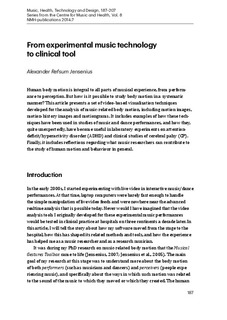| dc.contributor.author | Jensenius, Alexander Refsum | |
| dc.date.accessioned | 2015-03-20T08:53:38Z | |
| dc.date.available | 2015-03-20T08:53:38Z | |
| dc.date.issued | 2014 | |
| dc.identifier.citation | I: Music, Health, Technology and Design, s. 187–207 | nb_NO |
| dc.identifier.isbn | 978-82-7853-094-8 | |
| dc.identifier.issn | 1893-3580 | |
| dc.identifier.uri | http://hdl.handle.net/11250/279894 | |
| dc.description.abstract | Human body motion is integral to all parts of musical experience, from performance to perception. But how is it possible to study body motion in a systematic manner? This article presents a set of video-based visualisation techniques developed for the analysis of music-related body motion, including motion images, motion-history images and motiongrams. It includes examples of how these techniques have been used in studies of music and dance performances, and how they, quite unexpectedly, have become useful in laboratory experiments on attentiondeficit/ hyperactivity disorder (ADHD) and clinical studies of cerebral palsy (CP). Finally, it includes reflections regarding what music researchers can contribute to the study of human motion and behaviour in general. | nb_NO |
| dc.language.iso | eng | nb_NO |
| dc.publisher | Norges musikkhøgskole | nb_NO |
| dc.relation.ispartofseries | Series from the Centre for Music and Health;8 | |
| dc.relation.ispartofseries | NMH-publications;2014:7 | |
| dc.subject | video-based visualisation | nb_NO |
| dc.subject | human motion analysis | nb_NO |
| dc.subject | music-related body motion | nb_NO |
| dc.subject | research technology | nb_NO |
| dc.title | From experimental music technology to clinical tool | nb_NO |
| dc.type | Chapter | nb_NO |
| dc.type | Peer reviewed | nb_NO |
| dc.subject.nsi | VDP::Humanities: 000::Musicology: 110::Alternative musicology: 119 | nb_NO |
| dc.source.pagenumber | S. 187–207 | nb_NO |
